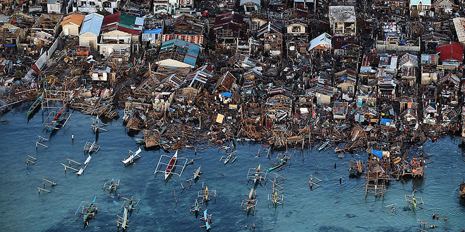Liability mechanism to strike an ambitious climate agreement
The question whether countries can be held liable for climate change damages is becoming a major issue in the UN climate negotiations. The discussion currently revolves around fairness and historical responsibility. We argue that a liability mechanism could also help countries to agree on an international climate treaty with more ambitious emission reductions.

The average number of natural catastrophes has nearly doubled from the 1980s to 2013. Most scientists attribute a great part of this increase to climate change. Overall, economic loss and damage from natural disasters in 2013 totaled around US$ 125 billion [1]. Impacts have been particularly devastating in poor, developing countries. At the same time, climate change is commonly attributed mostly to the high carbon emissions of the past two centuries in rich, industrialized countries.
Rules for Loss & Damage: justice and effectiveness
Due to this responsibility gap, developing countries are pushing negotiations for a mechanism to deal with loss and damage including clear compensation rules [2]. Those efforts originate in the idea that rich nations can be held liable for climate change-related damages based on their historical responsibility for carbon emissions. Loss and damage is often seen as a means to restore “climate justice” between developing and developed countries [3]. We argue, the existence of a compensation mechanism could also help to achieve a more ambitious climate agreement and thus more effective climate policies. Developing countries might be more willing to reduce their own emissions and invest in adaptation when industrialized countries acknowledge their historical responsibility by signing up to a liability mechanism. Industrialized countries in turn might reduce their emissions further, because they see developing countries also willing to share in the payment for climate protection and want to avoid paying compensation if climate change continues unchecked.
How liability rules can help reducing emissions
We tested this premise in an experiment that we conducted both with a group of delegates at the UN climate negotiations in Bonn in June 2014 and in an online experiment with a group of 700 participants from the United States. We designed a “game” where players were grouped into pairs, with one player having a higher starting capital than the other, mirroring the rich and poor nations divide. Each player decided whether to invest a part of their capital into climate protection. Via their investment, players could reduce the probability of a climate catastrophe able to negatively affect the capital endowment of the poorer player.
We imposed different liability rules for different groups of player pairs. We found that without any liability rule, few players decided to invest in climate protection. With a “strict liability” rule forcing the rich player to compensate the poor player for any damages, substantially more rich players chose to invest – but only few poor players. In two other groups we introduced distinct “negligence” liability rules: only if the rich player had not invested in climate protection did she have to compensate the poor player; or the poor player could only receive compensation if she had also invested in climate protection. These two groups achieved the highest reductions in the likelihood for climate damages, with most rich and poor players investing in climate protection. Importantly, this outcome also meant that in these two groups very few poor players actually suffered damages, and very few rich players had to pay compensation. Negligence liability rules were thus most likely to lead to an effective “micro climate agreement” in our experiment.
Looking ahead to Paris 2015
Our results suggest that policymakers would be well advised to intensify negotiations on a compensation mechanism for loss and damage in the run-up to the climate conference in Paris in 2015. Indeed, we find that a rather simple negligence rule makes cooperation more attractive and rewarding, leading rich and poor nations to boost their investments in mitigation and adaptation for climate protection. Far from opening up a Pandora’s box of endless compensation claims towards industrialized countries, a liability mechanism could make global climate cooperation more effective and less costly in the longer run.
References
[1] Munich Re: «external pageNatCatSERVICEcall_made»
[2] UNFCCC external pageLoss & Damagecall_made


